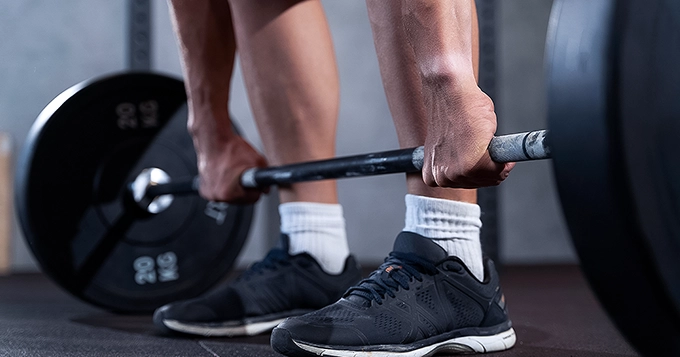
Key Takeaways
- Overexertion can lead to fatigue and mental health issues. Balance workouts with rest.
- Incorrect form increases injury risk and reduces workout effectiveness.
- Warm-ups and Cool-Downs prevent injuries and aid recovery.
- Monitoring workouts helps you see improvements and adjust your routine.
- Proper hydration is crucial for performance and recovery.
Navigating the world of fitness as a gym beginner can be intimidating. Avoiding certain common hazards is essential to ensuring a successful and injury-free start.
In this article, we’ll explore eight gym mistakes that every beginner should avoid to make their fitness journey more enjoyable and effective.
Avoid These Gym Mistakes
Overtraining

One of the most common gym beginner mistakes among those who are eager to see quick results is overwhelming yourself. Trying to overexert yourself to achieve too much in a short span will exhaust your limited amount of time, willpower, and energy. You’ll also frustrate yourself when you realize it actually takes longer to achieve your goal than you initially expected.
Before you get started, check out our “Beginner Workout for Women” guide for an easy-to-follow routine. It’s a great way to start strong and avoid common beginner mistakes. Explore the article to build strength and confidence from day one.
- Fatigue
- Decreased strength and endurance
- Depression
- Low motivation
- Insomnia
- Irritability
- Agitation
Using Improper Form

A gym beginner can successfully train the targeted muscles and notice faster results by performing certain exercises correctly. Additionally, it can lessen your chance of suffering from potentially dangerous injuries.
To prevent overstressing your joints or hurting your muscles, it’s critical to lift weights with good form.
Bad effects of improper form when exercising:
- Increased risk of injury
- Uneven stress on different muscle groups
- Joint stress
- Compromised stability
- Wasted energy
- Poor performance
Not Warming Up

Overstretching or not warming up enough might cause muscles to overwork. Excessive physical exertion can lead to inflammation, which in turn can cause pain and discomfort.
Skipping a warm-up before exercising can have negative consequences for your body. When you skip this crucial step, your muscles are not adequately prepared for the increased demands of physical activity. This puts you at a higher risk of muscle strains, sprains, injuries, and decreased performance.
Additionally, a warm-up helps increase blood flow to your muscles, enhancing flexibility and range of motion. Taking your time to warm up properly is a simple yet effective way to protect your body and optimize your exercise experience.
Skipping Cool Down

Skipping a proper cool-down after exercise is a missed opportunity for your body to recover and then adapt.
Cool-downs help gradually lower your heart rate and ease your body back to its resting state. Skipping this step may lead to blood pooling in your extremities, potentially causing dizziness or fainting.
Moreover, a cool-down aids in preventing muscle soreness and stiffness by promoting the removal of waste products, like lactic acid, from your muscles. Without a proper cool-down, the abrupt transition from intense activity to rest could slow down your body’s recovery process and hinder long-term flexibility and mobility. In summary, taking the time to cool down is essential for a safer and more effective post-workout experience.
Not Tracking Your Workout Sessions

The greatest method to gauge your progress is to take measurements. Unfortunately, it’s one of the most underutilized aspects of training.
Not tracking your workout sessions or progress can hinder your fitness journey by depriving you of valuable insights and motivation. Without a record of your exercises, sets, and repetitions, it becomes challenging to monitor improvements, identify weaknesses, or set realistic goals.
Tracking progress serves as a source of motivation, allowing you to celebrate achievements and stay committed to your fitness routine. Additionally, it helps in making informed adjustments to your workout plan, ensuring continuous growth and preventing plateaus.
The downsides to making this mistake are:
- You cannot see your progress
- Leads to a sense of aimlessness
- You cannot plan ahead
- You won’t know which works and what doesn’t
- Hard to know what to change in your routine
- You lose motivation
Ignoring Hydration

Overlooking hydration during workouts can have detrimental effects on your performance and well-being.
Water is essential for regulating body temperature, and dehydration can lead to dizziness, fatigue, and decreased exercise efficiency. Insufficient fluid intake can impair physical and mental function, making it harder to push through workouts and increasing the risk of heat-related illnesses. Inadequate hydration may also delay recovery, as water is crucial for nutrient transport and muscle repair.
Improper Rest

Both insufficient rest and excessive rest days can negatively impact your fitness journey.
Not allowing your body enough rest between workouts can lead to overtraining, which may result in fatigue, increased susceptibility to injuries, and decreased performance. Overtraining can cause tears or overstretching in muscles, tendons, and ligaments if it is not managed.
The most frequent overtraining injuries are to the neck and back, which commonly lead to upper and lower back chronic pain. Even when you recuperate from an injury, you may be more vulnerable to another one. Overtraining can also contribute to disrupted sleep patterns, mood swings, and a weakened immune system.
However, taking too many rest days can hinder progress and diminish the benefits of consistent exercise.
Other consequences of taking too many rest days include:
- Loss of fitness gains
- Reduced cardiovascular fitness
- Make weight control more difficult
- Muscle loss
- Joint stiffness and reduced flexibility
Finding a balance between challenging workouts and sufficient rest is key to a well-rounded fitness routine. It’s essential to listen to your body, incorporate rest days strategically, and pay attention to signs of fatigue or burnout to ensure a sustainable and effective workout routine.
Not sure what weight to lift

Choosing the appropriate weight for your workouts is crucial for achieving optimal results and preventing injuries.
Lifting only light weights may not provide sufficient resistance to stimulate muscle growth and can lead to stagnation in strength development. It may also limit calorie burn, hindering weight management and fat loss goals.
On the other hand, lifting excessively heavy weights can significantly increase the risk of injuries, compromise form, and contribute to overtraining and fatigue.
To determine the right weight for your exercises, aim for a balance that challenges your muscles while allowing you to maintain proper form. It’s crucial to start with a moderate weight and gradually progress as your strength improves.
If you’re unsure, consult a fitness expert who can offer tailored advice depending on your fitness level and objectives. Over time, it might be necessary to make adjustments to your weight selection in order to maintain a well-rounded and efficient exercise regimen.




